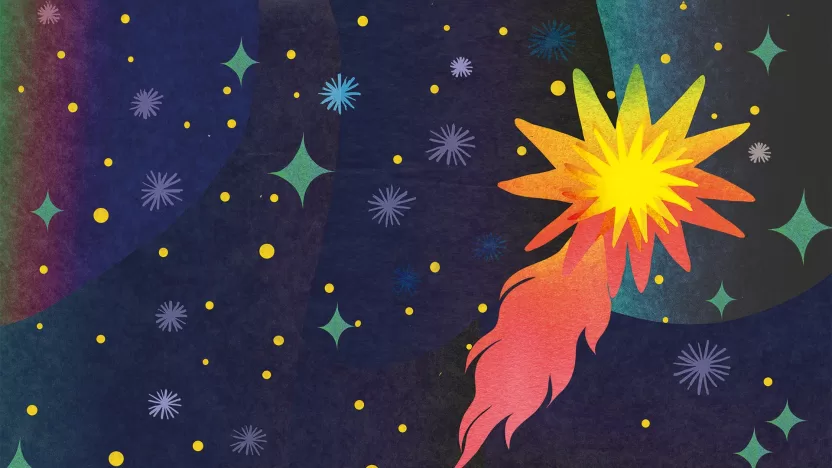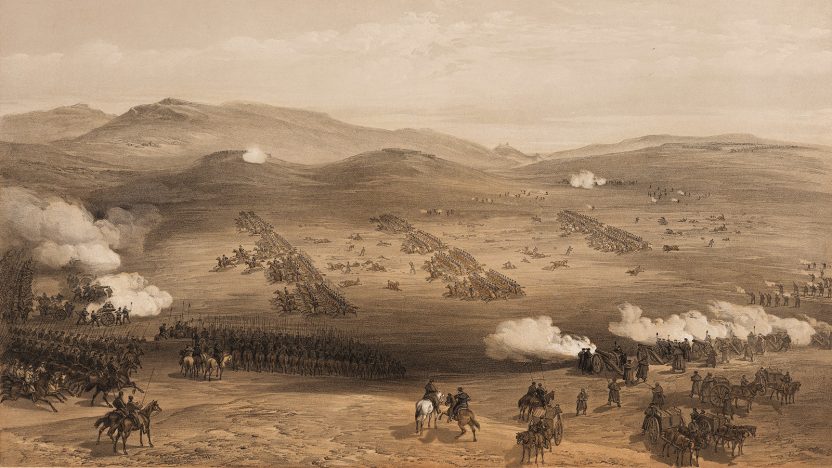Climate change needs a new definition
Defining Anthropocene as a geological era defines a feature of "modern" humans. It's time to face the facts.
by Etienne Turpin

From a scientific perspective, the Anthropocene is part of the geological record that marks the aggregate impact of more than seven billion human beings on the Earth system. In other words, our species is leaving a geological mark, on Earth itself, and in the future, it will be evident that humans were here. In this context, we could say that science is focusing on the -cene, that is, on measuring this impact and its consequences for the planet. The humanities, meanwhile, are focusing on the anthropos- by trying to answer the following questions: who is the “man” outlined by this new era? What are “his” defining features? And, how do these features also define, in part or in whole, Humans? Certainly, critical scholars have been enthusiastic about pointing out that the term Anthropocene threatens to collapse differences among various human groups by categorizing them all under the same epoch, and thereby, implicitly or explicitly, making them all equally responsible for the consequences humans leave behind as a species. But, is this really what the term Anthropocene does? Or, more precisely, perhaps, does humanity really need the discourse of the Anthropocene to promote or sustain inequalities?
We approach the issue from another perspective: if we look at the anthropos– in the term anthropogenic, and the anthropos– in the Anthropocene, the referent is the same. Why? Because these two anthropos- coincide in space and time; these two conceptions of the human are fundamentally the same. It is interesting that when the term anthropogenic made its way into the climate change debate in the ‘70s and ‘80s, no critics were concerned about this leveling of the anthropos-. No one suggested that climate change was actually capitalogenic or plantationogenic. Why? Because the anthropos- of the Anthropocene is a definition of the human as such. What does it mean to be human in relation to nature? Scholars in the Higher Education Industry want to answer this question, and define the Anthropocene, because, at the end of the day, this allows them to make claims on what it means to be human; in contrast, the anthropogenic is merely an ongoing process — but doesn’t define the species, nor does it help advance any scholar’s edgy academic brand, nor offer new fodder for any of the dying disciplinary skirmishes that constitute what we still call, amusingly, “academic debate.”
So, while a change in the definition of who or what humans are as a species is potentially consequential in terms of philosophical concepts and political convictions, the discussion has so far, for the most part, resulted in imbecilic and moral debates about whether we are a good or bad species, and whether the mark we leave on the planet can be turned into a universally positive form of agency, or not. Instead, we think one useful conceptual step would be to shift some of this discussion toward the concept of anthropo-supremacy. This move away from petty quips about –centrism, which is not really a problem from a conceptual point of view, to -supremacy, requires a change in perspective about the human species: we have always indulged in the idea of us being at the top of the evolutionary phylum because of our intelligence, but we have underestimated the dangers which accompany this presumed intelligence, such as self-destruction. In fact, as far as we know, nearly every species (more than 99% at least) that has lived on Earth has eventually become extinct; humans are just doing it much more quickly, to themselves, and to more or less every other form of life, because they are so very clever. But this cleverness, which is the result of numerous contingencies of evolution, also suggests, perhaps, that there is a chance to slow down the process of our own extinction. At least, in principle, this seems possible if we can understand the myth of our absurd species supremacism.
So, with this distinction in mind, we also introduced into our work the use of proximal demonstratives when discussing the Anthropocene in order to help shore up a certain conceptual specificity. We can only have this Anthropocene, in the same way, we could say that there’s a Mexican Anthropocene, a Malaysian Anthropocene, or a European Anthropocene. The geographical specificity is a way of saying that the Anthropocene is always instantiated somewhere that makes the meaning, texture, and substance of the human signature different, localized, and specific. We want to recognize the plurality of forms and means that constitute human impact, as well as the asymmetrical conditions between the north and the south, the rich and the poor, men and women; of course, between and among any number of culturally, ethnically o racially categorized bodies. From that perspective, the definition of the term is not as relevant to us as the mode of navigation we use to locate ourselves and our work within this Earth system.
Museums of natural history are temples of anthropo-supremacism: they project an image of Man as standing above nature through a series of different tropes, plots, and platitudes that are put in place both to hierarchize and securitize the presumed “natural” orders: man over nature, man over woman, adult over child, white over black, state over non-state, etc. But let’s be precise: that museums create an image of nature to sustain these hierarchies is not a problem because it is “anthropocentric.” Again, the problem is that the museum promotes an anthropo-supremacist image of nature: it is a form of supremacism that takes the idea of evolution and, rather than considering the human as a species that fell out of the bottom of the blind and contingent sifting process of evolution and accidentally gathered up the qualities that are necessary to develop a fairly complex, socialized brain, insists that humans grew out of the top as some ascendant apex species entitled to planetary predation and domination.
To better situate this dispute, we can briefly turn to an argument first posited by Freud. In his Introductory Lectures on Psychoanalysis, he explained the implications of psychoanalysis by situating psychoanalytic practice in a series of three humiliations, or, “narcissistic illnesses,” of Man: first, the Galileo humiliation, wherein the reality of a heliocentric system dislocated Man from the center of the universe; second, the Darwin-Wallace humiliation, where Man no longer has a God-given dominion over the world, but is (merely) the outcome of a random process of evolution; and, third, the Freudian-Psychoanalytic humiliation, according to which Man is not even transparent to himself. We can ask if this series is now extended even further: is the Anthropocene the fourth humiliation of Man? In the Anthropocene, not only are humans decidedly not psychically self-transparent, not divinely anointed to rule the plan, and not the center of the universe – but, even worse, perhaps – even when humans witness the aggregate destruction of their own activity, they appear to be fundamentally incapable of responding to the threat they pose to their own species: humans simply cannot stop themselves in the face of their own acceleration toward extinction.
Among this series, the Darwin-Wallace humiliation is particularly important with respect to our practice because it has shaped the image of nature through museum culture: this is key technology that compensates for the “humiliation of evolution” through a necroaesthetic substitution. The natural history museum becomes the site where Man presents nature to himself (i.e., necroaesthetically) better than nature presents itself, and thereby asserts His domination by other means. Every time one walks through a natural history museum, they repeat the biblical myth of Adam naming the animals through a series of secularized gesture, scenes, and configurations. This is a very powerful psychological technique that works to instill a conviction of anthropo-supremacy; it is a model that uses the trope of appreciation to engender a relationship of domination.
What would a natural history museum designed from non-anthropo-supremacist principles look like? How could it be organized? If we think about this clearly, the answer is almost ridiculously obvious: it would look like a forest, a living forest, with living beings living together, where plants would be growing free, and people would use them, share their knowledge about them, and build generational memory through practice and care. It would look like this because it would be this: a living forest. A living planet, even. It may sound strange, but we believe this aspect of our research is especially important: many, many people are extremely attached to the image of nature that natural history museums produce and promote. That is because, in the absence of any tradition of natural heritage, or any intergenerational and thereby transferable (inheritable) experience of natural processes, there is instead a conservative and frequently reactionary effort to maintain the image of nature conveyed in natural museums. How can we evade the vicious circle that perpetuates a necroaesthetic, conservative experience of the natural world that seeks, in turn and above all else, to preserve a distorted and dangerous image of nature?
In the context of our practice, these have become some very pressing questions in numerous projects that we are now working on. For example, how could the emergence of certain novel ecologies, particularly in coastal areas such as in Florida, Bangladesh, and Indonesia, change the trajectory of climate change for coastal settlements? How could the production of new forms stewardship, such as climate integrity land trusts – conceived as operative, living, natural history museums – help to redefine the human-nature relationship? Could we depart from the ways of viewing that are perpetuated by natural history museums and instead shift the human point of view to consider different kinds of natural environments or novel ecologies as more dynamic and consequential? In Florida, for example, as millions of residents have to move from the coasts, we are investigating if they would be willing to donate, sell, or otherwise transfer their properties in order to create aggregated plots of contiguous land that can be replanted as coastal forests and thereby build a natural legacy that isn’t dead and posturing, but instead is growing and increasing in value in dynamic ways.
These are cultural and political and scientific hypotheses: they require testing through the design, development, and deployment of new tools, platforms, and interventions. They cannot be tested as mere thought experiments, nor will thought experiments produce the necessary failures we need to design better and more compelling tools. To speak to one recent example that is close to us because of our commitments in Indonesia: when the government in Jakarta announced that, due the increasingly problematic floods in the capital, they will build a new capital city by deforesting even more of the island of Borneo and effectively abandoning the residents of the former capital to climate change and perpetual inundation, we can see one paradigm for the human legacy and impact in the Anthropocene: run away. The other, of course, is to double down and continue to build against nature’s own tendencies. But there would need to be something between complete militarization/securitization and total abandonment: we would need to meet the ecology halfway, which is actually something we have done as a species for millennia.
Let’s take another example to clarify this proposition: Venice, a city which is the result of numerous but difficult-to-detect processes: it was conceived and built over hundreds of years as a unique way of integrating the human into this lagoon ecology. Of course, since the beginning, it flooded, but it also afforded all kinds of securities: it was settled because it was a defensible area that couldn’t be attacked on either side by cavalry or large ships. It was too muddy for horses and too shallow for larger boats of troops to enter. Today, of course, people now think that building in the lagoon was an aesthetic feature, but this is absolutely not the case. Venice looks like it does because it is functional in the context of fifth-century self-defense. People today only see the aesthetic remnants of an existential choice but mistake them for decorative decisions. Like Venice, Jakarta is experiencing many challenges: Venice was not designed to host 25 million tourists a year, nor were Jakarta’s canals designed to process the sewage of 35 million residents. The typical design and engineering solutions used to respond to these problems are too frequently focused on path dependencies, when it is far more challenging to think about path inheritance: we have inherited the modality of the canal system in Jakarta or Venice, but how can we build into that, or work with what we inherit in a way that augments the situation?
The Anthropocene is a geological record of humans antagonizing and modifying the planet and recognizing the profound depth of their abilities to do so; but, it will also be the record of the actions that followed from this recognition. That story is only partial, and its conclusion is yet to be written: it will either be the record of a dramatic change in human society, which would probably also be discernible geologically, or it will record business as usual and the mass extinction that accompanies this approach. Relative to the speed of perception of the environmental collapse of other species, it appears the geological story is being written rather quickly. Humans could appreciate that speed of change or continue to ignore it. The question is how to take the scientific analysis into cultural and political forums and to initiate a broader public conversation about what is happening and what to do about it. This is where cultural practices have largely failed: the assumption was too often that the becoming-policy of science was a matter for technocrats and did not require cultural interpretation. Let’s stop doing this. We are working to shift the cultural response to major environmental reports (IPBES, IPCC, etc.) so that they can become foci for public conversations, direct action, and coordinated political struggle. If your house burns down, you’ll, of course, want to know the cause of the fire – but you don’t begin investigating while you’re trying to escape the burning house. So far, it seems the humanities have been arguing over the name of the fire; we think it is time to focus more intently on escaping the burning building.


